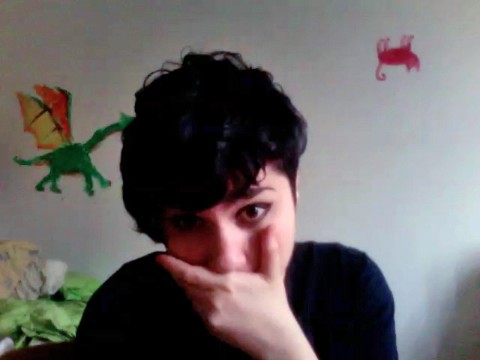Often referred to as “the Bonnie and Clyde of contemporary art,” Internet artists Eva and Franco Mattes are not only "partners in crime" but also the subversion of public media. Traveling the world both physically and virtually, they have produced, exhibited, and even stolen artwork. Now based in Brooklyn, New York, they continue to push net.art boundaries in exploits for which they repeatedly have been sued, banned, and (apparently) killed. Nonetheless, those reactions indicate the success of their pieces. As Franco explains, he is "interested in that moment of shock, that 'WTF moment.'"
Such moments largely result from the Matteses' engagement with the public: Outside of the art world context, they launched a media campaign for the nonexistent movie _United We Stand_ (2005), and, for their work _Freedom_ (2010), they disrupted an online multiuser video game by inserting their avatars and asking players not to kill them. Likewise, the Matteses produced _Nike Ground_ (2003) for a mass audience that was unaware of the truth or fallacy of their intervention. Through an advertising campaign, the couple convinced the Viennese population that the Nike Corporation had purchased Karlsplatz (the beloved town square of Vienna) with the intention of erecting a monument to the Nike logo and renaming the surrounding area Nikeplatz. After public uproar the hoax was revealed, prompting Nike to join the many entities that have sued the duo.
Art institutions also have fallen prey to the Matteses’ ruses. Inman Gallery in Houston has exhibited _Catt_ (2010), a taxidermy of two cats, and White Flag Projects in St. Louis has shown _Rot_ (2011), a jar of dead flies, under the assumption that the works were created by Maurizio Cattelan and Dieter Roth, respectively. Unwittingly, several of the world's most famous museums also have loaned their work to _Stolen Pieces_ (1995–97), the Matteses’ compilation of fragments removed from famous works by artists who include Beuys, Kienholz, Duchamp, Rauschenberg, and Kandinsky. Beyond simply being pranks, the duo’s exhibition of those and related works challenges notions of authenticity and ownership.
For such an effort, the Matteses also have utilized the Internet, as it remains an arena in which those concepts are ambiguous, if not false. For _Jodi.org_ (1999), they cloned another artist's website and presented it as their own, and _Vaticano.org_ (1999) undermined the Catholic Church. As it was a copy of the church’s official website, the work led to a yearlong impersonation of the Holy See. With _Life Sharing_ (2001–03), the Matteses submitted their personal computer files for public access, and _The Others_ (2011) comprised a slide show of ten thousand photos hacked from the personal computers of random individuals. The images, which obviously were intended for private viewing, often depict men flexing their muscles or women posing seductively for the camera. In a sense, the Matteses answered the call of the performative photographs, as many of the blatantly staged poses seem destined for an audience.
While amusing on one level, _The Others_ hints at the Matteses' aim to exhibit the unforeseen and unfortunate consequences of technologies that typically serve as modes of convenience and entertainment. The Matteses capitalize on the public's use of Internet as a means for alleviating boredom by offering their viewers with more of a diversion than they bargained for. In particular, the video _No Fun_ (2010) documents the Matteses' manipulation of Chat Roulette, a popular site wherein visitors are paired to chat with others randomly. In the work, Franco staged his apparent suicide by hanging. The right half of the screen displayed his body as it swung slowly from a noose for hours, while the left side depicted the reactions of viewers. Many people responded by laughing, insulting, or simply staring; only one person reported Mattes's death to the police. Ultimately, _No Fun_ was banned from YouTube. Like the video game intervention _Freedom, No Fun_ comments on the ease and pleasure with which death and violence are viewed and enacted on screen and in the safety and privacy of one's home.
In an effort to comment on such circumstances, the Matteses produced _Emily’s Video_ (2012). Playing off the popularity of "reaction videos" on YouTube, the artists asked volunteers to record themselves as they watched "the worst video ever." The following warning was issued at the beginning of the video: “_Emily’s Video_ is extremely graphic and extremely violent. EXTREMELY. We don’t recommend it to anybody.” Even after reading the warning, viewers continued watch as the Matteses took them to the underbelly of the Internet via a compilation of scenes culled from the Deep Web or Dark Net. Despite being largely inaccessible, the Deep Web is hundreds of times larger than the Surface Web and its content is often more disturbing, a fact evinced by the viewers' looks of disgust and disbelief.
As the original piece was destroyed, viewers are left to imagine the disturbing content of _Emily’s Video_ through the range of fascinating expressions on the faces of the volunteer viewers. In fact, those viewers become more engrossing and watchable than whatever might be on their screens—an aspect heightened by the Matteses' edit of the work for Landmarks. By not fitting the wide screen properly, the video is unbalanced in a way that seems to echo the distress of the viewers. Nonetheless, the visceral responses to _Emily’s Video_ raise questions about viewers' desires. Despite or due to the Matteses' warning as well as the pained looks of the volunteers, do we still want to witness the horror of actual graphic violence? Are the video, the Internet, or public media in general merely forms of entertainment? Or is there more than meets the eye to the images on our screens? _—Kanitra Fletcher_

